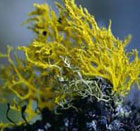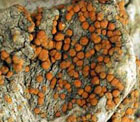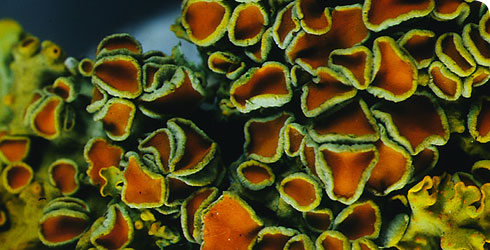Lichens
Lichens are such a familiar part of our landscape that often we don't even notice them. But lichens deserve attention. These mysterious organisms are biologically fascinating and come in a dazzling array of colours and sizes. Lichens also provide vital information about the health of our environment.
What is a lichen?

Leafy form of lichens
A lichen consists of 2 or more partners that live together symbiotically, with both of them benefiting from the alliance. One partner is a fungus. The other is either an alga (usually a green alga) or a cyanobacterium, which is sometimes called a blue-green alga although it is more closely related to bacteria than algae.
The alga or cyanobacterium is able to use sunlight to produce essential nutrients by photosynthesis that feed both partners. The fungus creates a body, called a thallus, in which they both live. The fungus also produces chemical compounds that may act as sunscreen to protect the photosynthetic partner.

Shrubby form of lichens
There are about 30,000 species of lichen worldwide, and they come in a dazzling variety of shapes and colours. Some are almost invisible to the naked eye and grow as a crust on rocks, trees or soil. Others are called beard lichens and these can be bushy or trailing, sometimes growing up to three metres in length, and others are lobed and leaf-like. Colours range from dull grey-browns to brilliant yellows and bright orangey reds.
Where do they grow?

Shrubby form of lichens
Lichens grow just about everywhere. They cover 8 per cent of the land surface, including some of the most extreme environments on Earth. Lichens flourish on rocky coasts and mountain summits, in icy polar regions and steamy tropical rainforests. Some prefer a single type of habitat such as limestone or sand dunes, while others are widespread and grow on different trees, soil and rocks.
Why are lichens useful?
Lichens are incredibly useful because they tell us about the health of our environment. Lichens are very sensitive to air pollution. As a rule of thumb, the smaller the variety of lichens in an area, the more polluted it is.

Crust-like lichen
In the past, sulphur dioxide from coal burning and industry was the worst pollutant. It killed lichens, so industrial areas with high levels of sulphur dioxide became lichen deserts. Levels have now dropped thanks to clean air laws and lichens are re-colonising those areas.
Nowadays, the major pollutants are nitrogen compounds from road traffic and intensive farming. These compounds don't destroy all lichens because some species positively thrive on nitrogen. So different pollutants create different patterns of lichen growth and, by understanding them, scientists are able to chart the health of our environment.
Some lichens grow very slowly so that they can tell you about the history of the substrate and the environment where you find them. They have been used as indicators of ancient woodlands that have never been clear-felled.
Lichens are also useful to their neighbours, recycling nutrients used by other plants and providing homes for spiders, mites, lice and other insects. Humans extract the most incredible range of wool dyes from lichens and also eat some of the edible species, while drug companies use lichens to make antibiotics or sunscreen cream.
